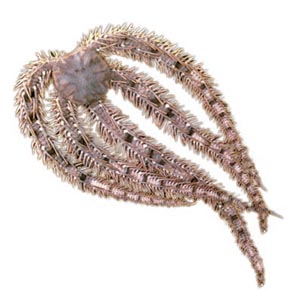
Sensing the growing shadow, it slithered away from its enemy, propelling itself with rapid, snakelike arm movements. Sounds like yet another episode in nature's daily drama of survival, but there's a puzzling catch - this creature doesn't have eyes.
Cousin to the sea urchin, sea cucumber, and starfish, the brittlestar is a marine invertebrate with five thin arms emanating from a disc like body, and no specialized eyes. How these sightless animals are able to detect shadows and hence flee danger has baffled investigators for years.
Weizmann Institute scientists, together with researchers at Bell Laboratories in New Jersey and the Natural History Museum in Los Angeles, now have an answer. Focusing on brittlestars of the species Ophiocoma wendtii, Profs. Lia Addadi and Steve Weiner of the Institute's Structural Biology Department discovered that these animals form crystal lenses in their skeletons. Recently reported in Nature, this unique 'visual' system is the first of its kind to be discovered in animals inhabiting the Earth today.
Addadi and Weiner had long been interested in the ways in which animals build their skeletons. Their research revealed that animals can produce different types of proteins, some of which control crystal formation.
The idea for the current study was born when they met Dr. Gordon Hendler of the Natural History Museum of Los Angeles County. Hendler brought to their attention one particular species of brittlestar that appears to be especially sensitive to changes in light, quickly escaping into dark crevices at the first sign of danger. It also changes its color from dark brown during the day to gray at night. Hendler suspected that the arrays of spherical crystal structures on the surace of its outer skeleton serve as lenses, transmitting light to the brittlestar's nervous system. His hypothesis was strengthened by the finding that these creatures have relatively extensive nerve networks. Moreover, the movement of pigmented cells between the crystal structures and the nerves appeared to alter the brittlestar's response to light.
Addadi and Weiner, together with their then graduate student Joanna Aizenberg, began to study the phenomenon. They discovered that each skeletal lens is actually a single calcite crystal. The crystal's optic axis is roughly perpendicular to the plane of the lens array, making it capable of transmitting light without the light being split in different directions. By analyzing the geometry of the lens they were able to pinpoint the expected focal point on the nerve bundles below. But is this light information really passed on as expected? In other words, do the lenses indeed guide and focus the light to effectively transmit it to the nervous system within?
This question remained unanswered for almost ten years, until the scientists found a way to examine the lenses using lithography, a semiconductor technology. The study was conducted at Bell Laboratories.
Aizenberg removed a calcite crystal array from the skeletal element of the brittlestar species Ophiocoma wendtii, placed it above a layer of photosensitive material, and exposed the system to light. She found that light had reached the photosensitive tissue in spots directly underneath the calcite crystals. By altering the distance between the lenses and the tissue, she found that the estimated focal distance of each lens - at which the lens concentrated the light by a factor of about 50 - coincided with the depth at which nerve bundles, which presumably serve as photoreceptors, are located in the brittlestar's body.
Like the human eye, then, the crystalline lenses and the pigmented cells in the skeleton of Ophiocoma wendtii act as 'corrective glasses,' filtering and focusing light on the phtoreceptors. But unlike man's ability to see in virtually only one direction, this complex visual system enables the brittlestar to detect approaching danger from any direction. The lenses also focus light at least 10 times better than any micro-lense manufactured today. Indeed, the unique brittlestar architecture is already giving rise to new ideas in materials science, such as the use of tiny lenses for various applications, including computers and telecommunication.
This is the first discovery of this type of visual system in animals, although Weiner notes that calcite crystals were used in the compound eyes of trilobites, marine animals now extinct, that inhabited the earth some 350 million years ago.
'The demonstrated use of calcite by brittlestars, both as an optical element and as a mechanical support, illustrates the remarkable ability of organisms, through the process of evolution, to optimize one material for several functions. It may also spark new ideas for future 'smart' materials,' say the scientists.
Prof. Lia Addadi holds the Dorothy and Patrick Gorman Professorial Chair. Her research is supported by the Minerva Stiftung Gesellschaft fuer die Forschung m.b.H.
Prof. Stephen Weiner holds the Dr. Walter and Dr. Trude Borchardt Professorial Chair in Stuctural Biology. His research is supported by the Helen and Martin Kimmel Center for Archaeological Science; Mr. George Schwartzman of Sarasota, Florida; and the Angel Faivovich Foundation for Ecological Research.


